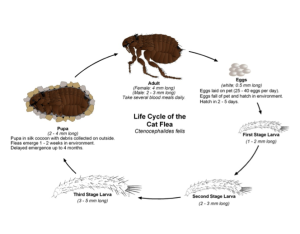Have you ever wondered why these small insects labeled as fleas are never dying out? Well, you are soon going to learn why. If there is a really amusing lifecycle, then it has to be that of fleas. The lifecycle of fleas has got only four stages, which are inclusive of egg, larva, pupa and adult.
The process
At the beginning of the lifecycle, the female lays eggs that are later hatched into larva. Later, the larva develops into pupae. What later comes up as a result of this is an adult flea. In every population of fleas, 90% are usually eggs.
Females only lay eggs once they have had a meal. So you can imagine that each time the fleas feed on your blood, they are ready to multiply. In a flea infested area or home, the fleas can hardly die out even in a span of years, which is why flea bites is a prominent problem. Notice that with improper elimination of the fleas, they will always be in that particular place. It can be very easy to eliminate mature fleas, but to do the same to their eggs is another very trying exercise. The pesticides that many people use only eliminate adults, but the eggs are not affected in any way. Notice that millions of eggs can be laid in a day by the adult females and that only means that the fleas bred in a single day are mind boggling.
Once a female leaves its cocoon and finds that there is no food to can feed on, the end result is always instant death and no reproduction takes place. You need to understand that what fleas feed on is blood.
Immediately a flea finds blood to feed on, instant reproduction takes place and one flea can lay up to 20 eggs in one span. A single flea has got the capacity to lay up to 500 eggs in its whole lifetime. This can already tell you that fleas are bred in such a short span, given that a flea can only survive in not more than 5 days.
In most cases, the flea lays the eggs on the host. For instance if the flea gets out of its cocoon in the fur of an animal, that is where it breeds. The eggs are really soft and slippery, so what happens is that the eggs slide off to the nearest environment. In a majority of homes what happens is that the eggs stick in carpets and other times woolen chairs and mature to adults.
For the eggs to develop, what they need is a really warm atmosphere of a temperature of about 70 degrees. That is the reason why the eggs are often bred in warm but moist environments. Once the eggs are in this kind of atmosphere, they are able to hatch in a span of about 12 days.
The larvae are white. As much as possible, they really avoid light and in most cases find their way to dark places like the cracks of walls. These do not feed on blood like the adult fleas do; rather they feed on the skin cells. Once there is really good and enough food, the adult flea then emerges from the cocoon in less than a week or so otherwise, it could stay in its cocoon for years.

